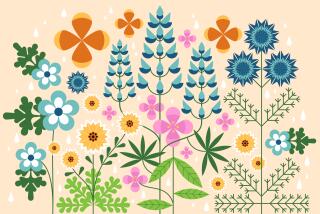Dirty Business, but Well Worth It
- Share via
Good gardens start from the ground up. Now, before a single seed is dropped into a furrow, is the time to fertilize, lime and either till or pull back any mulch.
Mulches protect and nourish but also insulate soils, keeping them cold in spring. If you mulch where you’re going to plant seeds or transplants, pull back or remove the mulch so the soil warms and seeds and young roots grow rather than rot.
Fertilize to replace nutrients that were removed with your harvest or otherwise lost from the soil since last fall. Ideally, a soil test tells you your soil needs. As a guideline, however, sprinkle about 3 pounds of a fertilizer containing 5% nitrogen (such as 5-10-5 or soybean meal) over every 100 square feet.
Also check your soil’s acidity. Alkaline soils in the West often need sulfur to make them more acidic. In the East, soils are often acidic, so they need limestone. Again, a soil test will tell you how much, if any, limestone or sulfur your soil needs. Never lime acid-loving plants such as rhododendrons, mountain laurels, azaleas or blueberries.
The final phase of spring soil preparation is tillage, which uproots weeds, smooths and aerates the soil and satisfies the itch to do something in the garden this time of year. Two rules for tillage: not too much, and not too soon.
Not too much: Your goal is not to reduce the soil to fine powder. Control the urge to run the tiller up and down the rows. Tilling with a shovel and a rake is a good way to thwart any tendency to overwork the soil.
Not too soon: Wait for the soil to dry a little before tilling. Working wet soils, especially clays, ruins their structure. The clay is bad for plant growth. Squeeze a handful of soil. If it crumbles easily, it is ready to till. If the soil wads up, let it dry more before tilling.
Not only should you not till when your soil is wet, but also make sure to ban foot, bicycle and tractor traffic.






